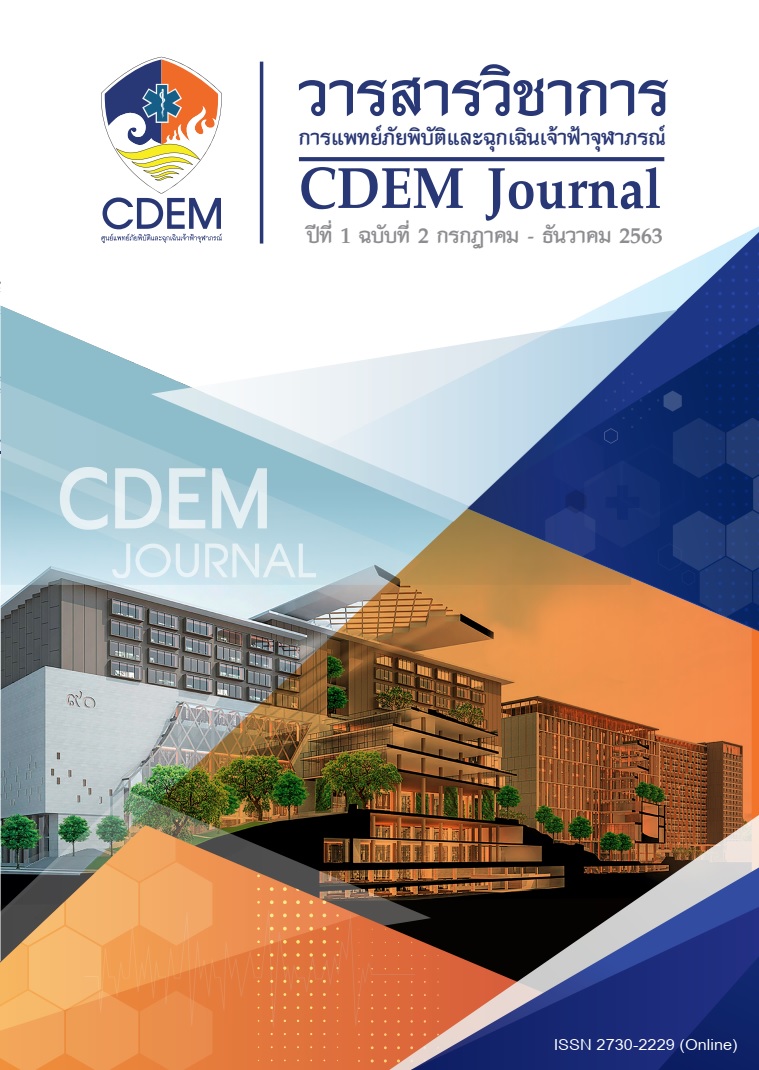Innovative Chiang Mai Manikin Trainer for Basic Life Support Training
Keywords:
Basic Life Support, Cardiopulmonary resuscitation training, CPR, Chest Compression ManikinAbstract
Abstract
Training of Basic Life Support (BLS) in Thailand is limited due to unavailable and costly devices for practicing. We developed a Chiang Mai Manikin to provide capable manikin for BLS training, and to determine the efficacy of training manikin compared to the actual model. Methods: This was a descriptive study of our newly developed Ching Mai Manikin. The prototype was determined by five experienced BLS instructors, including Cardiologists, Anesthesiologist, and Emergency Physicians. We used a questionnaire to evaluate the manikin’s structures, the efficacy of training, and its similarity to an actual model. Correlation among instructors was also calculated. Result: Chiang Mai Manikin trainer prototype was consisted of essential structures for BLS training and was effective for use in BLS training according to all experienced BLS instructors. The manikin was able to feedback on the duration of assisted ventilation and show the accuracy of electrode pads placement. Kappa correlation coefficient of the manikin trainer was 0.94. Evaluation of the similarity to an actual manikin with a visual analog scale resulted in a median of 37 out of 50 (IQR 34-40) accounted for 92.5%. Intraclass correlation was 0.79 (95% Confidence interval 0.19-0.98, p = 0.01) Conclusion: Chiang Mai Manikin trainer is effective in the use of BLS training.
Keywords: Basic Life Support, Cardiopulmonary resuscitation training, CPR, Chest Compression Manikin
References
1. Kleinman ME, Brennan EE, Goldberger ZD, et al. Part 5: Adult basic life support and cardiopulmonary resuscitation quality: 2015 American Heart Association guidelines update for cardiopulmonary resuscitation and emergency cardiovascular care. Circulation. 2015;132(18):S414-S435. doi:10.1161/CIR.0000000000000259
2. กลุ่มเทคโนโลยีสารสนเทศ สถาบันการแพทย์ฉุกเฉินแห่งชาติ. ผลการดำเนินงานของระบบบริการการแพทย์ฉุกเฉิน. สถาบันการแพทย์ฉุกเฉินแห่งชาติ. Published 2563. https://ws.niems.go.th/ITEMS_DWH/
3. Kragholm K, Wissenberg M, Mortensen RN, et al. Bystander efforts and 1-year outcomes in out-of-hospital cardiac arrest. N Engl J Med. 2017;376(18):1737-1747. doi:10.1056/NEJMoa1601891
4. Kronick SL, Kurz MC, Lin S, et al. Part 4: Systems of care and continuous quality improvement: 2015 American Heart Association guidelines update for cardiopulmonary resuscitation and emergency cardiovascular care. Circulation. 2015;132(18):S397-S413. doi:10.1161/CIR.0000000000000258
5. Chan PS, McNally B, Tang F, Kellermann A. Recent trends in survival from out-of-hospital cardiac arrest in the United States. Circulation. 2014;130(21):1876-1882. doi:10.1161/CIRCULATIONAHA.114.009711
6. Public-access defibrillation and survival after out-of-hospital cardiac arrest. N Engl J Med. Published online 2004. doi:10.1056/NEJMoa040566
7. Nielsen AM, Folke F, Lippert FK, Rasmussen LS. Use and benefits of public access defibrillation in a nation-wide network. Resuscitation. 2013;84(4):430-434. doi:10.1016/j.resuscitation.2012.11.008
8. ราชกิจจานุเบกษา. กำหนดให้การใช้เครื่องฟื้นคืนคลื่นหัวใจด้วยไฟฟ้าแบบอัตโนมัติเป็นการปฐมพยาบาล. (ราชกิจจานุเบกษา, ed.). ราชกิจจานุเบกษา; 2558:11.
9. สถาบันการแพทย์ฉุกเฉินแห่งชาติ. คู่มือสำหรับประชาชนในการช่วยชีวิตผู้ป่วยฉุกเฉิน ที่มีภาวะหัวใจหยุดเต้นด้วยเครื่อง เอ อี ดี.; 2559.
10. คณะกรรมการมาตรฐานการช่วยชีวิต, สมาคมแพทย์โรคหัวใจแห่งประเทศไทยในพระบรมราชูปถัมภ์. คู่มือการช่วยชีวิตขั้นพื้นฐาน และเครื่องช็อกไฟฟ้าหัวใจอัตโนมัติ (เออีดี:AED) สำหรับประชาชน. 1st ed. (คณะกรรมการมาตรฐานการช่วยชีวิต, สมาคมแพทย์โรคหัวใจแห่งประเทศไทยในพระบรมราชูปถัมภ์, eds.). บจก.ปัญญมิตร การพิมพ์; 2561.
11. Bhanji F, Donoghue AJ, Wolff MS, et al. Part 14: Education: 2015 American Heart Association guidelines update for cardiopulmonary resuscitation and emergency cardiovascular care. Circulation. 2015;132(18):S561-S573. doi:10.1161/CIR.0000000000000268
12. Younas S, Raynes A, Morton S, Mackway-Jones K. An evaluation of the effectiveness of the Opportunities for Resuscitation and Citizen Safety (ORCS) defibrillator training programme designed for older school children. Resuscitation. 2006;71(2):222-228. doi:10.1016/j.resuscitation.2006.03.014
13. Lee JH, Cho Y, Kang KH, Cho GC, Song KJ, Lee CH. The Effect of the Duration of Basic Life Support Training on the Learners’ Cardiopulmonary and Automated External Defibrillator Skills. Biomed Res Int. 2016;2016. doi:10.1155/2016/2420568
14. Yeung J, Davies R, Gao F, Perkins GD. A randomised control trial of prompt and feedback devices and their impact on quality of chest compressions-A simulation study. Resuscitation. Published online 2014. doi:10.1016/j.resuscitation.2014.01.015
15. Wik L, Thowsen J, Andreas Steen P. An automated voice advisory manikin system for training in basic life support without an instructor. A novel approach to CPR training. Resuscitation. Published online 2001. doi:10.1016/S0300-9572(01)00331-8
16. Wee JCP, Nandakumar M, Chan YH, et al. Effect of using an audiovisual CPR feedback device on chest compression rate and depth. Ann Acad Med Singapore. 2014;43(1):33-38.
17. Cheng A, Brown LL, Duff JP, et al. Improving cardiopulmonary resuscitation with a CPR feedback device and refresher simulations (CPR cares study) a randomized clinical trial. JAMA Pediatr. Published online 2015. doi:10.1001/jamapediatrics.2014.2616
18. Noordergraaf GJ, Drinkwaard BWPM, van Berkom PFJ, et al. The quality of chest compressions by trained personnel: The effect of feedback, via the CPREzy, in a randomized controlled trial using a manikin model. Resuscitation. 2006;69(2):241-252. doi:10.1016/j.resuscitation.2005.08.008
19. Lynch B, Einspruch EL, Nichol G, Aufderheide TP. Assessment of BLS skills: Optimizing use of instructor and manikin measures. Resuscitation. 2008;76(2):233-243. doi:10.1016/j.resuscitation.2007.07.018
20. Semeraro F, Frisoli A, Loconsole C, et al. Motion detection technology as a tool for cardiopulmonary resuscitation (CPR) quality training: A randomised crossover mannequin pilot study. Resuscitation. Published online 2013. doi:10.1016/j.resuscitation.2012.12.006
21. Fischer H, Gruber J, Neuhold S, et al. Effects and limitations of an AED with audiovisual feedback for cardiopulmonary resuscitation: A randomized manikin study. Resuscitation. Published online 2011. doi:10.1016/j.resuscitation.2011.02.023
22. Beckers S, Fries M, Bickenbach J, Derwall M, Kuhlen R, Rossaint R. Minimal instructions improve the performance of laypersons in the use of semiautomatic and automatic external defibrillators. Crit Care. Published online 2005. doi:10.1186/cc3033
23. Beckers SK, Fries M, Bickenbach J, et al. Retention of skills in medical students following minimal theoretical instructions on semi and fully automated external defibrillators. Resuscitation. Published online 2007. doi:10.1016/j.resuscitation.2006.08.001
Downloads
Published
Issue
Section
License
บทความที่ได้รับการตีพิมพ์เป็นลิขสิทธิ์ของวารสารวิชาการ การแพทย์ภัยพิบัติและฉุกเฉินเจ้าฟ้าจุฬาภรณ์
ข้อความที่ปรากฏในบทความแต่ละเรื่องในวารสารวิชาการเล่มนี้เป็นความคิดเห็นส่วนตัวของผู้เขียนแต่ละท่านไม่เกี่ยวข้องกับราชวิทยาลัยจุฬาภรณ์ และคณาจารย์ท่านอื่นๆในราชวิทยาลัยฯ แต่อย่างใด ความรับผิดชอบองค์ประกอบทั้งหมดของบทความแต่ละเรื่องเป็นของผู้เขียนแต่ละท่าน หากมีความผิดพลาดใดๆ ผู้เขียนแต่ละท่านจะรับผิดชอบบทความของตนเองแต่ผู้เดียว



